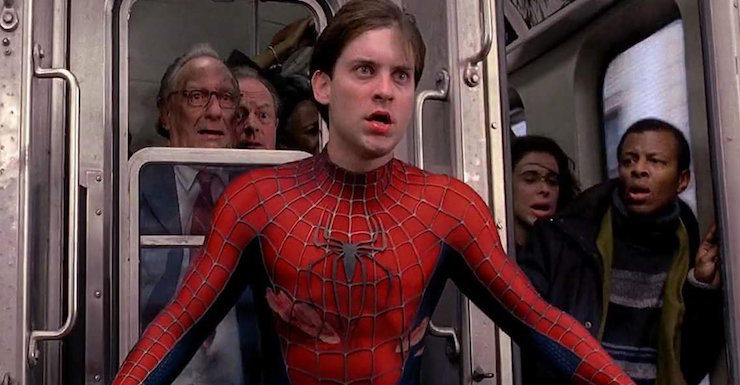One of the sources of Spider-Man’s lasting appeal has been his rogue’s gallery of villains. Over the 55 years of the character’s existence, he has had an impressive array of colorful bad guys to face. In fact, I’d argue that no other hero at Marvel has as wide a range of interesting villains as Spidey: the Green Goblin, the Vulture, the Hobgoblin, Venom, the Lizard, the Sandman, Electro, the Shocker, the Rhino, Carnage, Tombstone, the Scorpion, Kraven the Hunter, etc., etc., etc.
Having said that, the prime spot in Spidey’s rogues gallery has pretty much always belonged to Otto Octavius, a.k.a. Dr. Octopus. Many of the seemingly endless drafts of Spider-Man had Doc Ock as the bad guy before they settled on the Green Goblin instead. So it’s not real surprising that Octavius would be the villain in Spider-Man 2.
From his first appearance in Amazing Spider-Man #3 in 1963, Dr. Octopus was a compelling antagonist. Some of Spidey’s greatest stories have involved Ock as the bad guy, from the “Master Planner” storyline in Amazing Spider-Man #31-32 (in which Ock dropped twelve tons of machinery on Spider-Man’s back, and he threw it off himself in one of the all-time classic Spidey scenes) to the classic Superman vs. Spider-Man crossover (in which Ock teamed up with Lex Luthor to fight Supes and Spidey) to the recent “Superior Spider-Man” storyline (in which Ock succeeded in taking over Peter Parker’s body and posing as Spider-Man, wanting to prove that he would be a superior Spider-Man to the original).
When Cannon Films had the rights to a Spider-Man movie, Stan Lee wrote a treatment that had Doc Ock as the bad guy, and it tied Octavius’s work with radiation to the radioactive spider that bit Peter Parker and turned him into Spider-Man. When work began on Spider-Man 2, Doc Ock, the Lizard, and the Black Cat were all going to be villains in the story, which at first was written by Alfred Gough & Miles Millar (the developers of Smallville for what was then the WB). Other drafts were by David Koepp (writer of the first film) and Michael Chabon (author of The Amazing Adventures of Kavalier and Klay). Chabon, like Stan the Man, tied Octavius’s work to the genetically engineered spider that bit Parker in the first movie.
Alvin Sargent was brought in to sift through the three drafts with Sam Raimi and pick the best elements. In particular, Raimi wanted this film to emulate Superman II and the classic Spidey comics story in Amazing Spider-Man #50, “Spider-Man No More!” which ended with Parker giving up being Spidey, leaving his costume on a trash can in the iconic final panel, which Raimi re-created in this movie. (The deluxe box set DVD of the movie comes with a minicomic of ASM #50.)
Most of the cast from the first movie came back, including Tobey Maguire (Spider-Man), Kirsten Dunst (Mary Jane), Rosemary Harris (Aunt May), James Franco (Harry Osborn), J.K. Simmons (J. Jonah Jameson), Cliff Robertson (Uncle Ben), and Willem Dafoe (Norman Osborn). Of note regarding the latter three is that the filmmakers recognized how brilliant Simmons was in the first film, and so beefed up his role considerably in the sequel, and both Robertson and Dafoe come back for cameos as hallucinations of, respectively, Peter’s and Harry’s.
Alfred Molina was cast as Octavius, with Donna Murphy playing Rosalie Octavius, Daniel Gillies playing Jameson’s son John, and Dylan Baker playing Dr. Curt Connors. Rosalie was a new character created for the movie. In the comics, Octavius has really only had one love interest, a fellow scientist he knew before he went villainous. John and Connors are both from the comics, John first appearing in the debut issue of Amazing Spider-Man—his background as an astronaut is kept intact, though not his future as Man-Wolf—while Connors became the Lizard in the comics. The character later appears in The Amazing Spider-Man and actually becomes the Lizard, played by Rhys Ifans.
“I believe there’s a hero in all of us”
Spider-Man 2
Written by Alfred Gough & Miles Millar and Michael Chabon and Alvin Sargent
Directed by Sam Raimi
Produced by Laura Ziskin and Avi Arad
Original release date: June 30, 2004
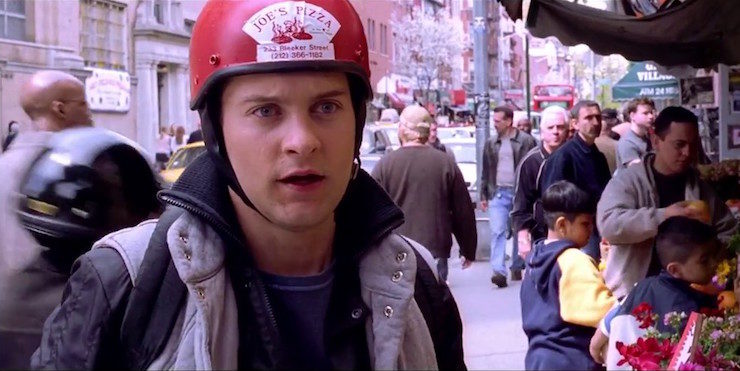
It’s been two years since the last movie (which we get a summary of in the form of comic-book-style artwork of still from the film over the opening credits—hey, remember when movies had opening credits? I really miss those days…). Harry is now running Oscorp and he’s funding a project run by Dr. Otto Octavius to harness tritium as an energy source. Peter is living in a crummy room-share and attending Columbia University, since Norman Osborn is no longer alive to pay for the nice apartment he and Harry lived in (and Harry’s living in the Osborn family mansion now anyhow). Why Peter hasn’t moved back in with Aunt May is never addressed, especially since she’s facing foreclosure on the house due to late mortgage payments. Mary Jane has gotten some modeling work and is in a production of The Importance of Being Earnest; she’s also dating the astronaut John Jameson, the son of J. Jonah Jameson. Peter has continued selling pictures of Spider-Man to the Jameson at the Daily Bugle, but Jameson continues to insist that Spider-Man is a menace. The web-slinger himself, however, is loved by most of the public.
Being a full-time superhero and a full-time student doesn’t leave much time for work. He doesn’t make enough as Spider-Man’s “personal photographer” to support himself, but his responsibilities as a superhero keep him from holding down a job. (We see him failing to deliver a pizza on time, even though he web-swings to the delivery destination.) It’s not doing his college career any favors, as one of his professors, Dr. Curt Connors, threatens to fail him if he doesn’t get his fecal matter together.
Peter is doing a paper on Octavius’s work. Connors is a friend of his, so he expects good things, and he’s working for Harry, and Peter is able to leverage his best friend to meet his idol. Octavius is reluctant to talk to some random student, but he is the boss’s best friend, so he agrees—however, Octavius, Peter, and Octavius’s wife Rosalie get along like a house on fire. Octavius invites Peter to attend the demonstration of his reactor.
Distracted by a crisis as Spider-Man, Peter is unable to make it to MJ’s play. MJ is disappointed, and pretty much writes him off, as he claimed to be her friend and there for her no matter what at Norman’s funeral, but he’s the only one of her friends and family who hasn’t seen her perform. She realizes the empty seat in the theatre is the perfect metaphor for their friendship.
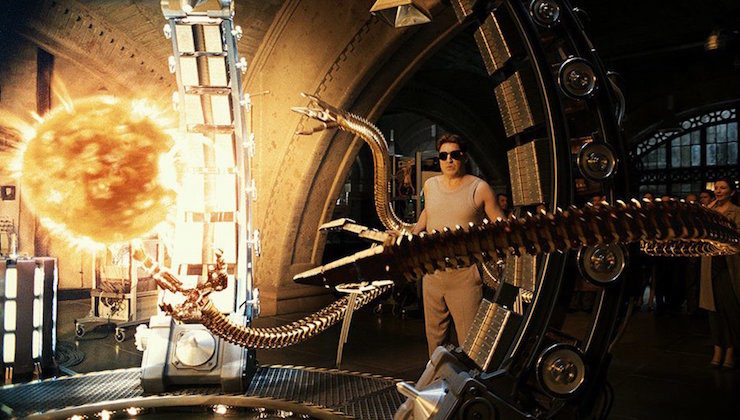
Octavius has his demonstration. (Hilariously, Peter has no trouble arriving on time for that.) He manipulates the elements with four “smart arms”—basically high-end waldoes that are hooked into his spine and respond to his thoughts. The experiment goes horribly wrong, but Octavius insists that it will stabilize and refuses to shut it down. The reaction becomes incredibly magnetic, and anything metal in the room is pulled toward the reaction. Peter changes to Spider-Man and manages to pull the plug on the reaction, but not before a window frame is yanked toward the reaction, the broken glass killing Rosalie.
Octavius is taken to the hospital where a surgical team tries to remove the arms, but the arms instead go crazy and kill everyone in the operating room. Octavius wakes up and leaves the hospital (completely unnoticed by security or anyone else, as no one seems to react to a patient killing an entire surgical team). Setting up in an abandoned dock, he decides to re-create his experiment, only with more tritium this time. In order to purchase the equipment, he robs a bank—one where Peter and Aunt May are unsuccessfully trying to get a loan to pay the mortgage. Spider-Man foils the robbery, though Octavius takes May hostage. However, Spider-Man saves her after an extended battle on the side of a building. (At one point, a chunk of debris falls to the sidewalk and almost hits a little girl, but she’s pulled out of the way by someone who looks just like Stan Lee.)
On several occasions, Spider-Man’s powers have cut out on him, to the point where he needs glasses again. (A doctor finds nothing wrong with him, and thinks whatever issues he’s having might be psychological rather than physical.) Between that, the fact that he can’t be with MJ when he’s a superhero because of the danger to her, and constantly reading in the Bugle that he’s a menace (the paper’s headline is that Spidey helped Octavius rob the bank, not that he stopped him), he decides to quit being Spider-Man, leaving his costume in a trash can in an alley. A sanitation worker finds the costume and sells it to Jameson, who hangs it on the wall and puts out a “SPIDER-MAN NO MORE!” headline.
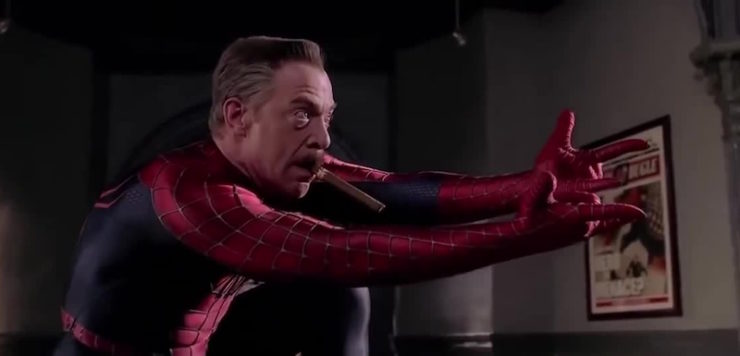
For a while, things are better. He gets to see MJ’s play and his grades improve. But May is still being forced to move out of her house, and MJ is still getting married to John Jameson. Plus, the crime rate is skyrocketing, and Peter eventually just can’t keep not helping people. He rescues a little girl from a fire, though someone else in the building did die whom he didn’t know about until it was too late.
Octavius has stolen or bought with stolen money all the equipment he needs—now he just needs tritium. He goes to forcibly take some from Harry, but Harry offers him a deal: bring him Spider-Man, and Octavius can have all the tritium he wants. Octavius agrees, and Harry tells him that Peter Parker is his best bet to find Spidey, given their relationship involving Bugle photos.
MJ and Peter have coffee. MJ can’t stop thinking about Peter and wants to find out where their relationship stands. She also wants to kiss him once, as she still thinks that Peter might be Spider-Man based on the similarities between their kisses.
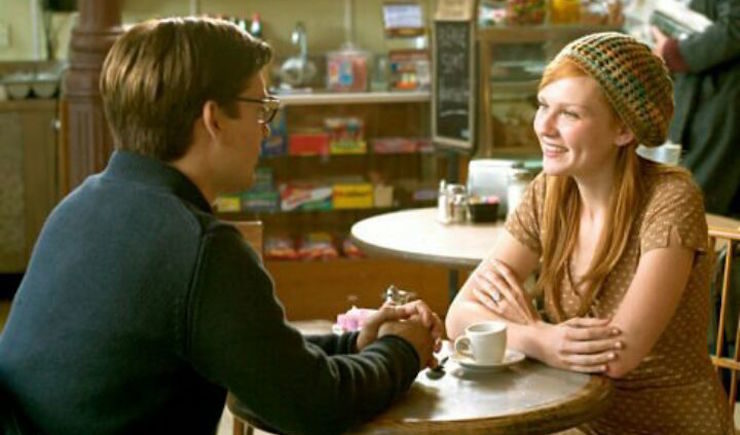
Before they can kiss, however, Octavius throws a car through the coffee shop window. He tells Peter to find Spider-Man and meet him at the West Side Tower, and he kidnaps MJ to accentuate the point.
MJ being kidnapped is enough to plow through whatever is going through his head and cutting off access to his powers, as he tosses debris aside and gets rid of his glasses. After stealing his costume back from Jameson, he goes to confront Octavius. They have an endless fight, which includes a lengthy sequence on an elevated train (neat trick, since they’re in Manhattan, and there’s very little by way of elevated trains in Manhattan, not to mention that none of them end as abruptly as this track does). Octavius sabotages the train forcing Spidey to stop it, a Herculean effort that exhausts him. The crowd on the train try to protect Spidey out of gratitude, but to no avail.
Octavius brings Spidey to Harry, who gives Octavius a crapton of tritium. Harry then unmasks Spidey and is shocked to see that he’s Peter. Already having trouble getting how his best friend could have killed his father, Peter convinces him to let him go to stop Octavius from destroying the city and killing MJ, whom he’s kidnapped. Harry, not knowing until now that Octavius has kidnapped his erstwhile love interest, lets him go.
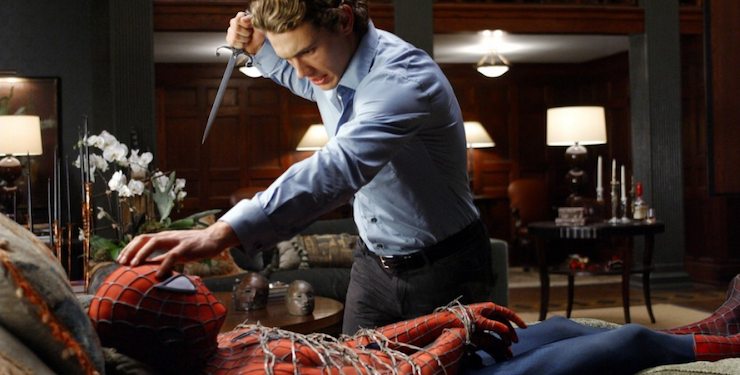
Octavius, with a bound MJ nearby, activates his new reactor, which has an even more violent reaction than the first one. Metal bits from all around the dock started being drawn in. Spidey shows up, and they fight. At one point, Octavius is electrocuted, and that, plus Peter unmasking to try to talk to him, gets him back to himself, as Peter reaches the good man he met at Oscorp rather than the psychopath he’s become. Determined not to die a monster, Octavius sacrifices himself to stop the reaction, which is now functioning independent of the reactor.
Meanwhile, MJ has now seen that Peter and Spider-Man are one and the same. He saves her life from a heavy bit of debris and admits that he loves her. But he also lets her go back to John’s waiting arms.
Harry is tormented by the revelation that Peter is Spider-Man, and a hallucination of his father in the mirror encourages him to kill him anyhow. Harry shatters the mirror in anger, and discovers that the mirror hid a secret door to a cache of weaponry and armor belonging to the Green Goblin. Harry now knows the truth about his father.
Days later, it’s the Jameson-Watson wedding, and MJ backs out at the last second, leaving a note for John and running to Peter’s apartment in her wedding gown. She declares that she loves him, and that she is a grownup whom he should let make her own decisions about who she wants to love, not self-righteously decide to protect her. Good for her. Then they hear sirens, and she encourages him to put on his Spidey suit and be responsible and stuff. He swings out the window, leaving MJ standing in his crappy apartment in a wedding dress.
“He’s just a kid, no older than my son”
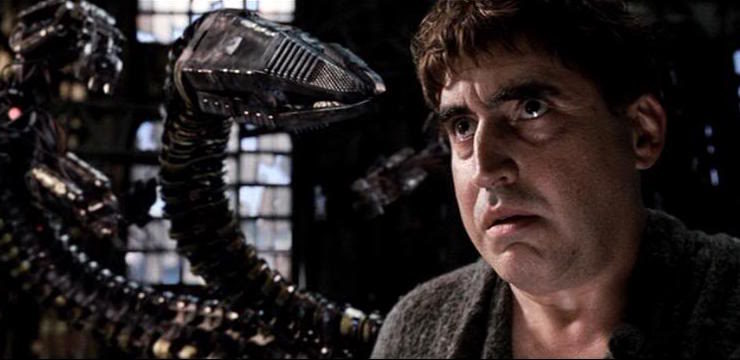
Let me start by saying that I’ve always loved Dr. Octopus as a villain as portrayed in the comics. I’ve even gotten to write the character, in a short story in the Untold Tales of Spider-Man anthology in 1997. (I’m proud to say that some of the things I established in that story later became part of the official canon, as it were, as Tom DeFalco incorporated it into a Doc Ock story in Spider-Man Unlimited that same year.) In the comics, Ock is a bitter, miserable person, a genius who had a horrible upbringing, and turned into a psychopath. He was always a worthy foe of Spider-Man, a brilliant scientist and clever tactician. The Superior Spider-Man storyline where Octavius took over as Spider-Man was a simply fantastic storyline by Dan Slott, one of the cleverest takes on the Spidey/Ock rivalry.
I’ve always loved Alfred Molina, and he does a decent job with this role, it just doesn’t come across to me as the Otto Octavius I’ve been reading about for all these decades. And that isn’t in and of itself a bad thing, but what they changed him to is spectacularly uninteresting and badly handled.
Okay, first of all, they completely botch the notion that Octavius was a nice, compassionate guy until the accident that killed his wife. It could have worked, but as actually shown, it’s ridiculous, as they play it as if the arms themselves are somehow controlling him, or at least influencing him. On top of that, at no point do we see Octavius actually mourning his wife, or responding to the fact that he’s killed tons of people—like, say, when Peter brings him back to himself at the very end. One utterance of “I will not die a monster” isn’t enough. Bad enough that they fridged Rosalie, but they don’t even really do anything with it.
Ultimately, the psychotic break seems to be happening because of the arms, a notion that doesn’t really make any sense, and both gets Octavius off the hook and makes Dr. Octopus completely uninteresting as a villain.
And that’s only half the problem with the movie. The fight scenes are decently done, but there are too many of them, and they go on too long. Maguire continues to be a good Peter Parker—I especially love the bit at the reception when he keeps trying to grab an hors d’oeuvre or a drink and not getting to the tray until it’s empty, which is a classic example of the ol’ Parker luck—but his Spider-Man is lifeless. That was workable in the first movie because it was the first movie and he was still feeling his way around, but now he’s two years into being Spidey and the best he can come up with for witty banter is telling a kid to eat his vegetables?
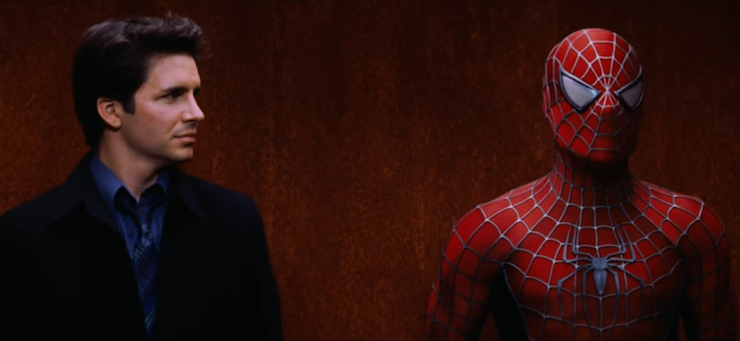
One of the problems with Spider-Man as a live-action hero is one of the things that makes him effective as a superhero with a secret identity. An issue generally with superheroes in live action is that the feebleness of the disguise is more obvious. This goes all the way back to the first-ever superhero movie, Superman and the Mole Men, where George Reeves did nothing to differentiate Clark Kent from Superman in any way, so it’s impossible to credit that nobody has figured out the secret identity. This continued for a long time, as seen in so many places, brought into sharp relief in, as one example, the Justice League of America pilot in which Guy Gardner’s girlfriend doesn’t recognize him under the domino mask Green Lantern wears, which strains credulity well past the breaking point.
Spider-Man’s costume has always been one of the better ones for preserving a secret ID because all the usual indicators of identity are hidden: skin tone, hair color, distinguishing marks, facial hair, and eye color are all completely obscured, and you can’t really tell his height either, because he spends most of his time doing odd acrobatics and generally gadding about with his spine practically folded in half.
But—as we’ll see again in the MCU with Iron Man—this means that your lead actor’s face is hidden, which makes it hard for said actor to be expressive. In the climax of the first movie, this was addressed by having Green Goblin’s weapons cut through the mask, revealing part of his face. It’s far worse in this movie, as Spider-Man loses his mask at several critical moments so Maguire can be expressive—particularly the dopey elevated train rescue. (Digression: it’s not dopey because it’s a train rescue—it’s actually a classic villain move, distracting the hero by endangering innocents, and I like the way the people on the train support Spidey in the end, though the mosh-pit bit when they bring him onto the train is goofy as hell. No, it’s dopey because the elevated train setup makes nothing like sense, especially that sudden end to the tracks and a drop off. All elevated subway tracks in New York end at actual stations with much more structure past the end of the tracks precisely so something like that doesn’t happen with an out-of-control train.)
But ultimately, while I always felt like I was watching a story about Peter Parker, I never once felt like I was watching Spider-Man. Part of Spidey’s appeal is that he’s a regular person, but a good one, who has problems, but who is also a hero, and who is also generally optimistic despite the best efforts of the universe, and also one with a great sense of humor. We get the problems, and we get the heroism, but we also get a Peter who’s a bit too mopey, and we never get the friendly neighborhood Spider-Man, just a CGI effect whose primary dialogue while web-swinging is a loop of the “woo hoo!” from the first movie.
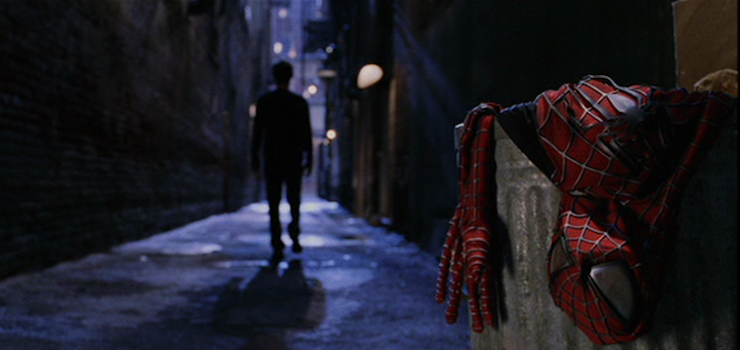
As for the rest of the cast, Molina does well with what he has to work with, and while wearing a really weird outfit (a duster over an exposed torso and the harness for the arms), even if the script fails him. Rosemary Harris is a perfect Aunt May, from her slapping the wrist of the bank manager who tries to steal a gold coin to her hero speech to Peter that is part of what inspires him to put the Spidey suit back on. J.K. Simmons continues to hit it out of the park as Jameson. Kirsten Dunst doesn’t have nearly enough to do as MJ, but I like the way she whups Peter upside the head, both after he fails to show up for her play and she proceeds to list everyone who did make it, and at the end when she tells him to let her decide for herself who to love. (Having said that, leaving John at the altar is a really skeevy move and doesn’t make her look good at all. Sure, it seems like a grand romantic gesture, but mostly it’s screwing the Jameson family out of money and being spectacularly rude to your wedding guests.)
Unfortunately, James Franco doesn’t come across well at all here. His performance is all surface, and not even a very nice surface. He just doesn’t sell Harry as a person at any point in the movie, least of all when he stumbles backwards after unmasking Spidey and it feels like we’re watching a high school senior try to act. It’s weird, because Franco’s generally an excellent actor, as recently as the first film, but he’s just completely off throughout this one.
Overall, a disappointing sequel, but it did well enough to justify making a third in 2007, which we’ll cover next week.
Keith R.A. DeCandido is pleased to announce that his high fantasy/police procedure series is back in print with the re-release of a new edition of Dragon Precinct from eSpec Books. This new edition also has the bonus short story “Gan Brightblade vs. Mitos the Mighty.” Coming soon are new editions of Unicorn Precinct, Goblin Precinct, Gryphon Precinct, and Tales from Dragon Precinct, followed by the long-awaited next book in the series Mermaid Precinct.










